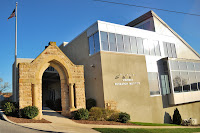The Windber
Research Institute is proud to be part of the just published online article in
the journal Nature http://www.nature.com/nature/journal/vaop/ncurrent/full/nature11412.html
(September 23rd, 2012) by The
Cancer Genome Atlas (TCGA) Network entitled “Comprehensive molecular portraits of human tumors.” Together with
our military collaborators, the Walter Reed National Military Medical Center
(WRNMMC), we provided breast tissue specimens, DNA and relevant donor data for
this ground breaking research. A total of fifteen Tissue Source Sites were
involved in this national scientific project sponsored by the National
Institutes of Health (NIH). Our journey to such a success story was as expected
not very easy. Our efforts through the years to acquire and maintain the very
best quality tissue specimens paid off when we qualified to become tissue providers
for TCGA. The strict qualification criteria of this project kept us on our
toes. Our qualification rates were usually between 85% and 100%. We were highly
commended by the Biospecimen Core Resource group (Nationwide Children’s
Hospital Biospecimen Core) as they compared our performance with that of the
other tissue source sites. All this attests to the hard work and dedication of
our staff. Their constant and daily efforts to provide the highest level of
efficiency and perfection made it possible for us to be part of this major
scientific project. As a small not for
profit research institute established twelve years ago, we are proud to be in
the same playing field with institutions such as Duke University, Mayo Clinic,
MD Anderson Cancer Center, University of Pittsburgh and University of North
Carolina at Chapel Hill to mention just a few of the other Tissue Source Sites
for this project.
In
this project, 800 breast tumors were genetically characterized using multiple
technological platforms. The study was able to characterize four major
sub-types of breast cancer (HER-2 enriched, Luminal A, Luminal B, and
Basal-like) as previously described and provided a more comprehensive
understanding of the mechanism behind each type of breast cancer. Furthermore,
the study identified molecular similarities between one sub-type of breast
cancer and ovarian cancer. Charles Perou, PhD, the corresponding author says
“This study has now provided a near complete framework for the genetic causes
of breast cancer which will significantly impact clinical medicine in the
coming years as these genetic markers are evaluated as possible markers of
therapeutic responsiveness.” Dr. Perou is the May Goldman Shaw Distinguished
professor of Molecular Oncology at the University
of North Carolina at Chapel Hill and a
member of UNC Lineberger Comprehensive
Cancer Center
The
tissue bank at Windber will continue to engage in ground breaking research
activities in the coming years. This will encourage our donors and help with
new therapeutic targets for treatment to alleviate the sufferings of the many
breast cancer patients out there. We are working for you!

















